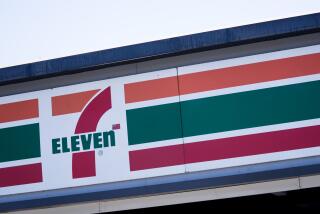Police Boxing Club Takes a Positive Poke at Gang Crime
HUNTINGTON PARK — Some of the teen-agers danced and poked at punching bags while others skipped rope under the bright lights in an old building in the western part of the city.
Flanked by a new boxing ring, heavy bags and speed bags, Police Chief Patrick M. Connolly spoke of the fledgling youth boxing club he organized and about how he does not want to see young lives wasted by gang warfare and drugs.
“It gives kids something to do, something they can take with them the rest of their lives,” Connolly said Monday.
The Huntington Park Athletic Club is in its first full week of operation. The club’s grand opening is not scheduled until mid-February, but more than 80 young people have already signed up, club Director Jose M. Mercado said.
The goal is to provide area teen-agers with a constructive activity to fill their nights so they are not as likely to be involved with gangs or drugs, Connolly said.
The teen-agers are still receiving rudimentary training, and it will be a couple of weeks before they begin sparring, said trainer Hector Rodriquez, who added that he hopes to have some of them ready to compete in amateur bouts in three or four months.
“Keep your hands up! Keep your hands up!” Rodriquez told one youth who was pummeling a heavy bag. “Do some sit-ups. Get that belly hot,” he told another.
On the other side of the gym, a teen-ager danced and punched in front of a mirror. Then a horn sounded, signaling everyone to shift to different equipment.
“If we can get these kids off the streets and show them there’s something aside from gang banging, we’ve done something,” said Rodriquez, 65, a former amateur boxer and longtime trainer.
Mauricio Salazar, 16, of Huntington Park, was one of about 30 youths training Monday night. “I have weights at my house, but it was kind of boring,” said Salazar, who would like to compete in amateur bouts. Salazar said he also trains for self-defense, “to get stronger for the streets--if I get jumped or something.”
Connolly said he has patterned the club after the successful boxing program associated with the Los Angeles Police Department’s Hollenbeck station. Boxer Paul Gonzales, a former Olympic gold medalist, trained at Hollenbeck.
The Huntington Park club is open from 4 to 8:30 p.m. weekdays and from 10 a.m. to 2 p.m. Saturdays. The club is free for young people ages 8 to 18. Mercado said it has already reached its capacity, but he is seeking volunteer instructors to allow more youngsters to participate.
The chief and his men started setting up the athletic club after they secured a one-time, crime-prevention grant of $125,000 from the state Office of Criminal Justice Planning. The grant pays for the salaries of Mercado and Rodriquez, most equipment costs and the rent. Local merchants donated much of the paint and other materials and labor to whip the gym into shape. Connolly said the department will seek other grants and community support to keep the club open and to add more programs, such as an aerobics class for girls.
Gang Problems
Police say the Southeast area has gang problems, even though they are not as serious as those afflicting South-Central Los Angeles.
Youth gangs in the area include The Brats, the Kansas Street Boys, the King Cobras, the Midnight Boys and the Clan, officials said. During the Thanksgiving weekend, two people were hospitalized with wounds suffered in three drive-by shootings in Huntington Park, police said. Six juveniles were arrested. Police believe the shootings were all gang-related.
Connolly hopes the boxing programs will have another benefit.
When Connolly was hired last January, he inherited a department with a serious public relations problem. The department had just gone through an embarrassing trial in which two former officers were convicted of using a “stun gun” to torture a teen-age burglary suspect during an interrogation. Dist. Atty. Ira Reiner called the department an embarrassment to law enforcement.
The chief said the program allows the department to interact with youths in a positive way and develop community support. “Just by the nature of our job, you have to deal with negative aspects,” Connolly said. “We want to show them we are concerned, that we want to do something positive.”
More to Read
Go beyond the scoreboard
Get the latest on L.A.'s teams in the daily Sports Report newsletter.
You may occasionally receive promotional content from the Los Angeles Times.










